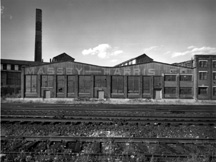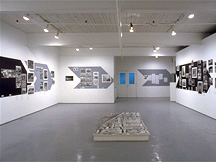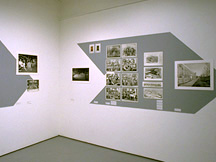- MAIN INDEX | ARTIST INDEX
| March 1 - 26, 1988 Peter MacCallum
| |
 Peter MacCallum, "Detail of South Facade, Massey Ferguson Toronto Plant", 1986. Photo Peter MacCallum. 18K | |
 Peter MacCallum, "Industrial Zone", 1988, installation view. Photo Peter MacCallum. 18K |  Peter MacCallum, "Industrial Zone", 1988, installation view. Photo Peter MacCallum. 18K |
| PRESS RELEASE
Peter MacCallum's solo exhibition Industrial Zone is a photographic installation about the now abandoned Massey-Harris-Ferguson factory complex in downtown Toronto. The installation will be based on MacCallum's own architectural photographs of the plant taken in 1986, and will also include archival photographs, aerial survey photos, images from the company's promotional material and film newsreel footage. In the interview accompanying the exhibition, the artist comments on his role in the installation: Through this exhibition, MacCallum aims to restore people's consciousness of a place which was important to the economic and social life of the city, and is now being replaced by commercial development. Industrial Zone is the artist's first exhibition in recent years. Previous exhibitions include Spadina Ave: A Photohistory, curated by Rosemary Donegan, at A Space (1984), and Alternate Photography, curated by Richard Rhodes, at YYZ, (1983). Peter MacCallum's photographs have also been reproduced in numerous publications, such as Spadina Avenue by Rosemary Donegan, 1985, and The House that Jack Built, by John Massey, 1986. His work is represented in the collections of the City of Toronto Archives and Varity Corporation.
Soulful photographs profile life and death of a Toronto factory John Bentley Mays
PETER MCCALLUM'S Industrial Zone, on view at Mercer Union (333 Adelaide St. W.) to March 26, is a harvest of photos about the vast (and now abandoned) Massey-Ferguson factory on King Street West; The exhibition, which has been installed with uncommon dullness-- the labels were peeling off the walls the day after the opening--profiles the great farm-machinery manufacture from its birth in the nineteenth century to its death, in this decade. In historical images gathered from company archives and public collections, and in McCallum's patiently composed, melancholy photos of the deserted factory buildings, we are given a panoramic look at a small world that endured for more than a century. And in its heyday, Massey-Ferguson was a world, complete with brass bands and staff dances, dramatic labor confrontations and heavy politics-- a population of thousands, all tending the immense complex of machines and electricity at the centre of it all. McCallum's explicit intentions in this show are to restore people's consciousness of a place which was important to the economic and social life of the city. Also to show aspects of a culture which is in decline." Exactly why Torontonians should care about the demolition of the Massey-Ferguson complex is not made clear in these comments -- after all, urban cultures are always in a state of flux - though there are surely excellent reasons for being concerned about the fate of these buildings. After all, North America's huge heavy-industrial comp1exes are the cathedrals of the Late Iron Age, richly expressive of a certain belief in progress, liberation from toil, and abundance through mechanization that has been largely dashed. But unlike the cathedrals, factories are surprisingly fragile, and are being ripped down everywhere, often before anyone does technical documentation of their elegant electro mechanical systems and architectural structure. This exhibition is sufficient as far as it goes; it does convey a certain nostalgia for a way of life that's passing in Toronto, if not in Hamilton or Lackawanna. McCallum's photos, still and silent as snow-covered cornfields, do a good job of embodying this mood of sadness (though without saying why we should be sad). What's largely missing is any strong concern for the cultural knowledge that is in danger of being lost. Rather than soulful views down long, deserted production floors, we would like to have detailed pictures of the high-voltage conduits and switches, brickwork decorations on the exterior, the office furniture that will almost certainly never find its way into a museum collection, before this tremendous fact of cultural memory has been swept away forever. .
| |